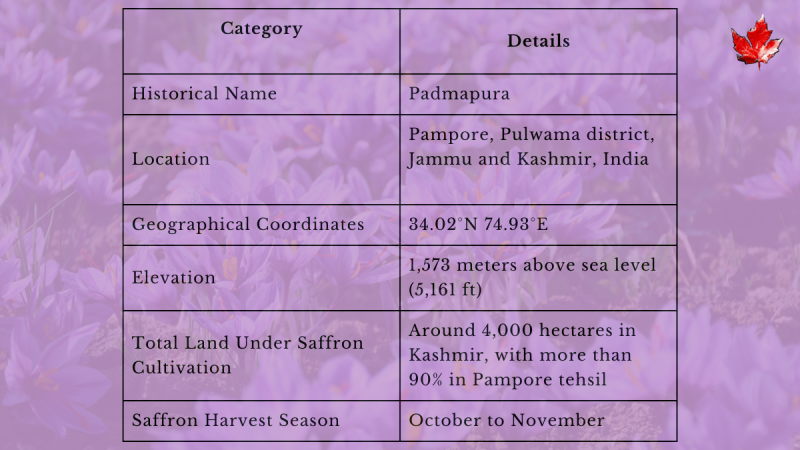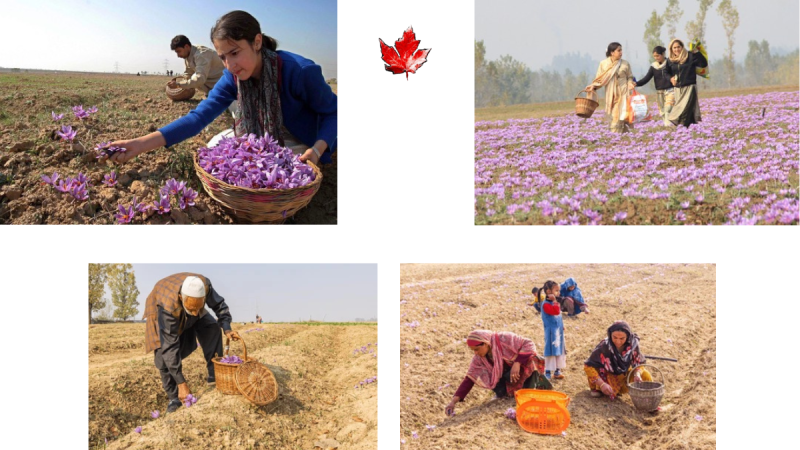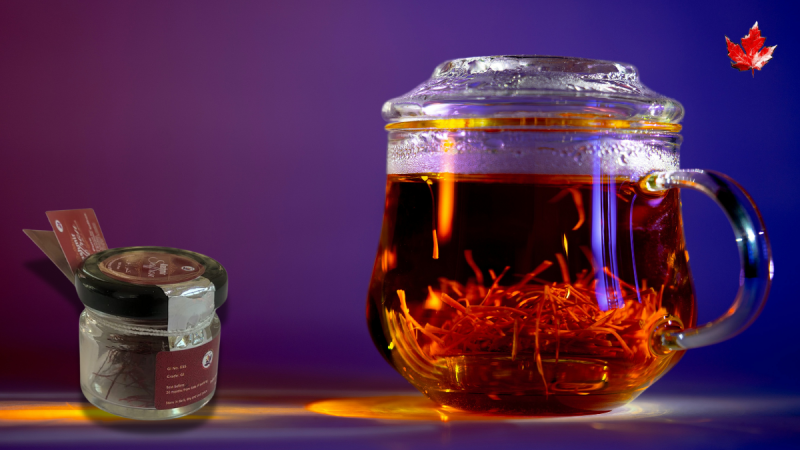Pampore – The Saffron Valley of Kashmir
Even before you see it, its fragrance reaches you. The air is filled with the sweet, floral scent of saffron, welcoming you to its homeland.

PAMPORE, a small town in Jammu and Kashmir’s Pulwama district, is known as the Saffron Capital of India. This is where the globally recognised Kashmiri saffron, often called red gold, is grown. Located on the eastern side of the Jhelum River, Pampore has fertile Karewa soil, an ideal climate, and centuries-old farming traditions, making it a blessed place for planting the finest mongra saffron.
The region produces nearly 90% of India’s saffron, earning it the title of the country’s saffron heritage site. But how did it all begin?
Did saffron originate in Kashmir, or was it brought here?
While history offers many versions, the locals have their own beliefs about saffron’s roots.
Origins of Kashmiri saffron in Pampore
Saffron and Kashmir have been inseparable for centuries. Some say saffron arrived in Kashmir as early as the 1st century B.C., with references in Kalhana’s Rajatarangini marking its deep historical roots. Others believe it was brought by Central Asian immigrants, while another theory links it to Persian rulers, suggesting they introduced saffron around 500 B.C.
But history is not just about facts, it is also about stories passed down through generations. And Kashmir has its own.
According to local folklore, saffron came to the region in the 11th or 12th century AD when two Sufi saints, Khwaja Masood Wali (R.A.) and Hazrat Sheikh Sharifud-din Wali (R.A.), fell ill while traveling through Kashmir. The locals cared for them, and in gratitude, the saints gifted a saffron crocus bulb to a tribal chieftain. To this day, this act of generosity is honoured with prayers during the saffron harvesting season. In Pampore, Kashmir’s saffron site, a golden-domed shrine stands in their memory.
However, not everyone agrees with this tale. Kashmiri poet and scholar Mohammed Yusuf Teng argues that saffron has been cultivated in Kashmir for over two millennia, long before the saints arrived.
And if you ask the saffron farmers of Pampore, they will tell you another story. They believe that Shaikh Bab Sahib, a revered saint, prayed for divine blessings upon the region’s soil, making it the only place in India where saffron flourishes.

Saffron Growing Villages in Pampore
Pampore is known as the saffron capital, but its saffron fields extend far beyond. The villages of Khrew, Gundbal, Wadipora, Wuyan, Ladoo, Lethpora, Dussu, and Koil together account for nearly 80% of Kashmir’s saffron production.
With fertile Karewa soil, a desirable climate, and generations of farming expertise, these villages have preserved the practice of saffron cultivation for centuries.
Every saffron harvest is a celebration of tradition, labour, and nature’s gift to this region, not merely a seasonal occurrence.
The Unique Climatic and Soil Conditions of Pampore
Saffron grows in numerous areas, but what distinguishes one kind from another is the habitat in which it grows. Pampore’s saffron owes its exceptional quality to a perfect combination of climate, soil, and geography.
The region comes with distinct seasons, with cold winters and warm summers, both of which are essential for saffron cultivation. During its growing period, the temperature ranges from 15°C to 20°C. The freezing winter allows the plant to rest and prepare for the next cycle.
Pampore’s soil has an equally important role. Saffron corms blossom in this light, well-drained, and nutrient-rich soil. The sandy loam texture and slightly alkaline pH (about 7 to 8) provide the right balance of moisture and aeration.
Furthermore, the adjacent Himalayan mountains influence the region’s microclimate, keeping heavy rains from harming the fragile saffron blooms.
Pampore’s saffron is regarded as one of the best in the world due to its unique combination of natural components.
What Makes Pampore's Saffron Special?
Kashmiri saffron, particularly from Pampore, is regarded as the best in the world due to its superior quality, deep red colour, strong aroma, and intense flavour. These attributes are a result of the high concentration of crocin, picrocrocin, and safranal, the natural compounds responsible for saffron’s distinctive properties.
But it is not all about the chemistry.

The way Kashmiri saffron is grown and processed matters too. It is cultivated using traditional methods, with no artificial additives or pesticides. Farmers hand-pick each flower with care, and the delicate stigmas are dried to lock in their natural quality. This age-old process keeps Kashmiri saffron pure, authentic, and one of the rarest and most expensive varieties of saffron.
Pampore’s High-Tech Saffron Spice Park
The India International Kashmir Saffron Trade Centre (IIKSTC), also known as the High-Tech Spice Park, is a major breakthrough for saffron farmers in Pampore, Jammu and Kashmir. Located in Dusoo, Pulwama district, this modern facility is designed to improve saffron quality and support farmers, especially during the post-harvest stage.
One of the most difficult issues saffron farmers encountered was preserving quality after harvest. Previously, farmers dried saffron flowers at home, but this traditional approach frequently altered moisture levels, resulting in variable quality and lower market pricing. The High-Tech Spice Park allows them to process saffron under regulated conditions, ensuring purity and higher profit margins.
The facility speeds the stigma separation process by providing four huge halls, 10,000 trays, and 100 growers each hall. Farmers also have access to modern cold storage, which helps to preserve freshness while retaining natural aroma and colour. Saffron quality is monitored by a modern scientific lab, which tests parameters such as moisture content to ensure high standards are met.
With all stages from processing to packaging handled in one place, Pampore’s high-tech spice park has simplified the work for growers.
Best Time to Visit Pampore for Saffron Fields
There is always a best time to visit any place, and for Pampore, it is from late October to early November, right in the middle of the saffron harvest season. This is when the Karewa plateau turns purple, as delicate crocus flowers cover the landscape.
It’s also the time for the Pampore Saffron Festival, a celebration of Kashmir’s culture and traditions. You can watch local farmers and their families carefully pick the world’s most expensive spice.
Feel the spirit of Kashmir come alive through music, dance, and traditional crafts. A visit would be incomplete without tasting saffron-infused delicacies like Kashmiri Kahwa and Zafrani Pulao.
Your trip does not have to end with the saffron fields. Visit the Awantipora Ruins, old 9th-century temples dedicated to Lord Vishnu and Shiva that offer a look into Kashmir’s history.
Conclusion
A town representing Kashmir’s saffron heritage. Pampore, with its scented saffron fields and historical monuments, is a must-see getaway for anyone who admires Kashmir. Whether you’re a visitor, a foodie, or just interested about where India’s best saffron comes from, Pampore is sure to impress you.
Planning to Buy Pure Kashmiri Saffron Online?
To get 100% authentic saffron at reasonable prices, make sure you buy from trusted local sellers in Pampore. Compare prices for a gram, ounce, or kilogram of saffron across different suppliers. Look for deep red strands, a strong aroma, and a slightly bitter taste.
Kashmir Stuff makes it easy by selling authentic Pampore-grown Kashmiri saffron online.